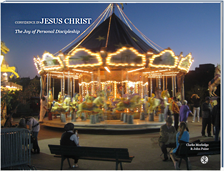In this final blog post in this series, looking back over the trip my wife and I made to Europe, during this past Christmas, I want to return to the very first historical site we visited in Belgium: Waterloo.
Waterloo is less than a 45 minute drive from where we were staying with friends, south of Brussels, Belgium. Waterloo was where the great French emperor of the early 19th century, Napoleon, met his demise at the hands of his British and Prussian enemies.

The Lion’s Mound at Waterloo, a constructed hill that allows the visitor to gaze upon the battlefield where Napoleon’s career as a military leader met its end. In this photo, I thought the contrast with the jet trail complemented the rising slope of the Lion’s Mound.
Waterloo has an entirely underground museum to orient the visitor. I enjoyed it, except that the audio system for listening to English translations of the exhibits was extremely frustrating to use (that is just a tip for those who plan on visiting Waterloo!!). But the greatest reward was in getting a chance to walk around outside above ground and explore the battlefield. It was a remarkable, sobering experience.
Looking out over the battlefield, just a few days after Christmas (2023), it had been a few weeks since Ridley Scott’s Napoleon movie had been released, so I was very much in the moment, having remembered how Ridley Scott depicted the battle on screen. I had also recently finished listening to Bernard Cornwell’s excellent audiobook, Waterloo: The History of Four Days, Three Armies, and Three Battles, which chronicles the end of the Napoleonic era. I tried to take everything in, as I gazed across the gently rolling fields below.

A battlefield map, at the top of the Lion’s Mound at Waterloo, showing the field positions of Napoleon’s army approaching from the south, and Wellingtons’ army holding fast from an area just below the Mound, where I was standing.
In reading Cornwell’s book, as well as Tim Blanning’s magisterial The Pursuit of Glory: The Five Revolutions That Made Modern Europe: 1648-1815, I was stunned by Napoleon’s hubris. Just a few years prior to Napoleon’s devastating loss at Waterloo, he had taken around half a million European soldiers on a march towards Moscow, Russia, only to overextend his supply lines and get caught in the Russian winter, such that only around 70,000 troops made it back to Western Europe alive, where most of the dead suffered not through fighting, but rather by cold, disease, and starvation.
Yet Napoleon’s thirst for victory was still not dampened by the defeat in the Russian campaign. Napoleon’s grand army that assembled on these fields near Waterloo nearly pulled off a victory against the Prussian general, Gebhard Leberecht von Blücher, and the British general, the Duke of Wellington. Napoleon was only but a few hours from obtaining victory against the Prussian and British/Dutch armies who faced him. But it was all for naught.
As I stood atop the “Lion’s Mound” to survey the battle scene, I could imagine the horror of men perishing on these fields, driven by the mania of one man whose hubris would cost them their lives.
Apparently, the type of ideological obsessions which animated Napoleon in the early 19th century continues to drive humans just a little over 200 years later to the same acts of madness. Whether it be the Gaza/Israel conflict or the Ukraine/Russia conflict, the loss of life and property is of staggering proportions. College student protests over the past few months only tell part of a complex story, drawing on complicated tales of competing historical narratives.
We must pray. We must pray for peace.
Will we in the 21st century learn from Napoleon’s failed ambition? Will we learn from the Bible?
He shall judge between the nations,
and shall decide disputes for many peoples;
and they shall beat their swords into plowshares,
and their spears into pruning hooks;
nation shall not lift up sword against nation,
neither shall they learn war anymore. (Isaiah 2:4 ESV)
Thanks for joining me the past few months on some memories of spending a Christmas in Europe!




What do you think?